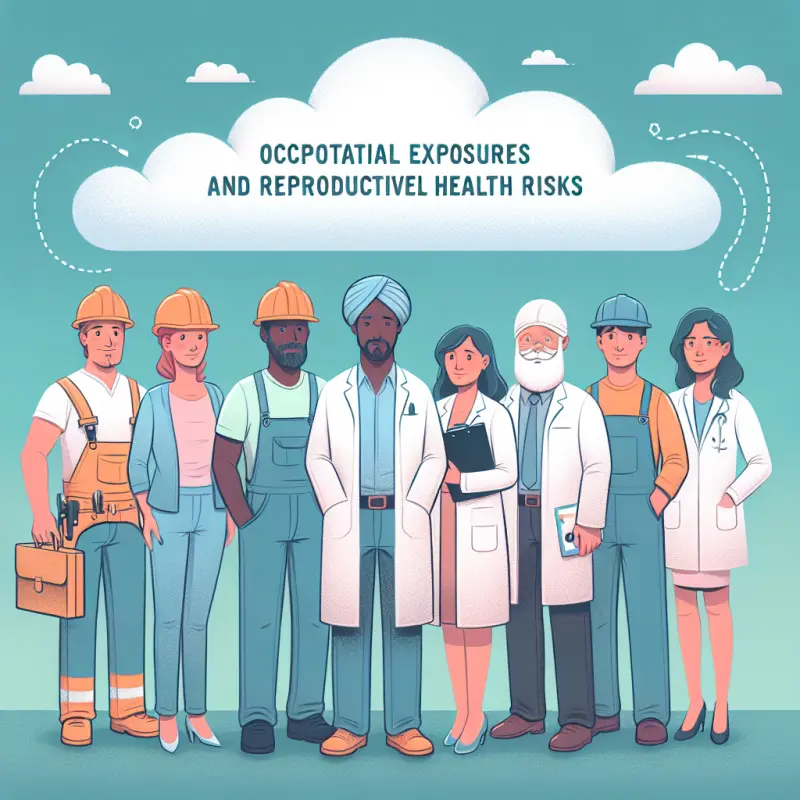Occupational Exposures and Reproductive Health Risks

Occupational Exposures and Reproductive Health Risks
Introduction
In today's dynamic work environment, understanding the interplay between occupational exposures and reproductive health risks is crucial. Many workers are subjected to various physical, chemical, and biological agents that might adversely affect their reproductive health. This article aims to shed light on how different occupational exposures can potentially lead to reproductive health issues, the underlying mechanisms, and measures to mitigate these risks.
Reproductive health is a state of complete physical, mental, and social well-being in all matters relating to the reproductive system. It is not merely the absence of disease, dysfunction, or infirmity. For working individuals, maintaining reproductive health is essential not only for their personal well-being but also for the health of future generations. This article will explore the types of occupational exposures that pose risks to reproductive health, the epidemiological evidence supporting these risks, and strategies to protect workers.
Types of Occupational Exposures
Occupational exposures refer to any physical, chemical, or biological agent that a worker may encounter in the workplace. These exposures can vary significantly across different industries and job roles. The primary types of occupational exposures include:
1. Chemical Exposures
-
Solvents: Common in industries such as painting, cleaning, and manufacturing. Solvents like benzene, toluene, and xylene have been associated with adverse reproductive outcomes, including infertility and developmental defects in offspring.
-
Pesticides: Widely used in agriculture, pesticides have been linked to reproductive harm, including reduced fertility, spontaneous abortions, and congenital disabilities.
-
Heavy Metals: Lead, mercury, and cadmium are prevalent in various industrial processes. Exposure to these metals can impair reproductive function and lead to adverse pregnancy outcomes.
2. Physical Exposures
-
Radiation: Workers in healthcare, nuclear plants, and research laboratories may be exposed to ionizing radiation, which can damage reproductive cells and lead to birth defects or infertility.
-
Heat and Noise: High temperatures and excessive noise in industries like manufacturing and construction can affect reproductive health, particularly in males, by impairing sperm quality.
3. Biological Exposures
- Infectious Agents: Healthcare and laboratory workers are at risk of exposure to infectious agents like the Zika virus, cytomegalovirus, and toxoplasmosis, which can cause severe congenital disabilities.
4. Ergonomic and Psychosocial Exposures
- Stress and Shift Work: Chronic stress and irregular work hours can disrupt hormonal balance and menstrual cycles, affecting fertility.
Mechanisms of Reproductive Toxicity
Understanding how occupational exposures lead to reproductive health issues involves exploring the biological mechanisms at play. Various pathways through which these exposures exert their effects include:
-
Genotoxicity: Certain chemicals and radiation can cause DNA mutations in germ cells, leading to infertility or congenital disabilities.
-
Endocrine Disruption: Many chemicals, including some pesticides and plastics, can interfere with hormone function, affecting reproductive organ development and fertility.
-
Oxidative Stress: Exposure to heavy metals and solvents can lead to oxidative stress, damaging reproductive cells and tissues.
-
Neurotoxicity: Some substances, like certain solvents, can affect the nervous system, indirectly impacting reproductive health by altering hormone regulation.
Epidemiological Evidence
Case Studies and Research Findings
Numerous studies have investigated the relationship between occupational exposures and reproductive health outcomes. Key findings include:
-
Solvent Exposure and Fertility: A study among female healthcare workers found that those exposed to anesthetic gases had higher rates of spontaneous abortion.
-
Pesticides and Birth Outcomes: Research in agricultural communities has consistently shown an association between pesticide exposure and adverse birth outcomes, such as low birth weight and preterm birth.
-
Radiation and Congenital Anomalies: Workers exposed to high levels of ionizing radiation have shown increased rates of congenital anomalies in their children.
Gender Differences
Reproductive health risks from occupational exposures can differ between males and females due to biological and physiological differences:
-
Male Workers: More susceptible to fertility issues from exposures like heat, noise, and heavy metals, which can impair sperm quality.
-
Female Workers: More likely to experience menstrual disturbances and adverse pregnancy outcomes from chemical and biological exposures.
Mitigation Strategies
Addressing occupational exposures and their reproductive health risks involves a multi-faceted approach:
1. Regulatory Measures
-
Occupational Safety and Health Standards: Governments and organizations should enforce strict regulations on permissible exposure limits for hazardous substances.
-
Regular Monitoring and Audits: Workplaces should conduct regular exposure assessments and audits to ensure compliance with safety standards.
2. Workplace Practices
-
Personal Protective Equipment (PPE): Employers should provide appropriate PPE, such as gloves, masks, and protective clothing, to minimize exposure.
-
Engineering Controls: Implementing ventilation systems, isolation of hazardous processes, and automation can reduce exposure levels.
-
Workplace Health Programs: Initiating health surveillance programs to monitor workers' reproductive health and providing education on minimizing exposure risks.
3. Individual Actions
-
Health Education: Workers should be educated about the potential reproductive health risks associated with their job and trained on safe work practices.
-
Lifestyle Modifications: Encouraging healthy lifestyle choices, such as a balanced diet and regular exercise, can mitigate some of the adverse effects of occupational exposures.
Conclusion
The relationship between occupational exposures and reproductive health risks is complex and multi-dimensional. While certain jobs and industries pose higher risks, understanding the mechanisms and evidence behind these risks is crucial for developing effective mitigation strategies. By establishing robust regulatory frameworks, adopting safe workplace practices, and promoting individual health education, we can protect workers' reproductive health and ensure a healthier future generation. Continuous research and policy development are essential to address emerging risks and improve occupational health standards worldwide.